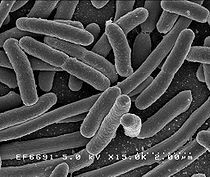by
Brendon Nafziger, DOTmed News Associate Editor | December 23, 2009

The future is now
as scientists blur
the line between
organism and machine
Nature's humblest organisms might one day power micro-sized machines, if research reported in the Proceedings of the National Academy of Sciences pans out.
In experiments at the Argonne National Laboratory in Argonne, Ill., scientists have employed common aerobic bacteria to spin microscopic gears.
The microgears, a mere 380 microns long and manufactured in conjunction with researchers at Northwestern University, twirl in a soapy solution.




Ad Statistics
Times Displayed: 44472
Times Visited: 1374 Keep biomedical devices ready to go, so care teams can be ready to care for patients. GE HealthCare’s ReadySee™ helps overcome frustrations due to lack of network and device visibility, manual troubleshooting, and downtime.
"What is surprising is that [the bacteria] move this object," Igor Aronson, a physicist at Argonne and lead investigator on the study, tells DOTmed News. "The gear is about one million times heavier than an individual bacterium. Somehow, they push it, they collide with the surface of the gear, and they push it in a certain direction."
The tiny gears move because they're designed with certain asymmetries, Aronson says. The bacteria, which dart about nearly at random, smack into the gear from all angles. The net force of their collisions, coupled with the gear's asymmetric design, causes it to spin in the appropriate direction.
Water molecules, Aronson notes, although they too ping about the dish at random, don't have the germs' staying power that's needed to move the gears.
"Water molecules are not persistent," he says. "They collide with the gear and bounce back. Bacteria swim and when they collide with the surface of the gear, they keep pushing."
Even better, the bacteria can move two gears together, as in a motor or a clock. By using a soapy solution that's slightly concave, so the gears tend to set next to each other, the scientists can help ensure the germs spin the gears with their spokes in contact.
Just right
The research, also carried out by scientists at Princeton, had to ensure proper quantities of bacteria. Too low a concentration of the germs, a species known as Bacillus subtilis, and they weren't strong enough to move the microgears. But too many, on the order of more than 40 billion per cubic centimeter, and they began to stop moving and secrete a biofilm.
"The optimal range of concentration is from something like 10 billion to three times 10 billion," says Aronson.
Aronson says that at high concentrations, the bacteria seem to react to a chemical signal they emit which somehow prompts the biofilm buildup. But as with much about bacterial behavior, there's still much that's unknown.
"It's not fully understood," he admits.
Still, the scientists do have some control over the germs. By controlling the amount of oxygen present in the dish, they can change the speed of the gear rotation: as the bacteria are aerobic, and need oxygen to function, the researchers can increase their speed by pumping in oxygen, and slow them down, or even bring them to a halt, by drawing oxygen out.

